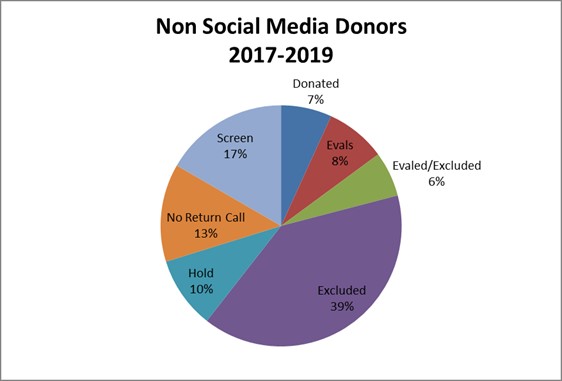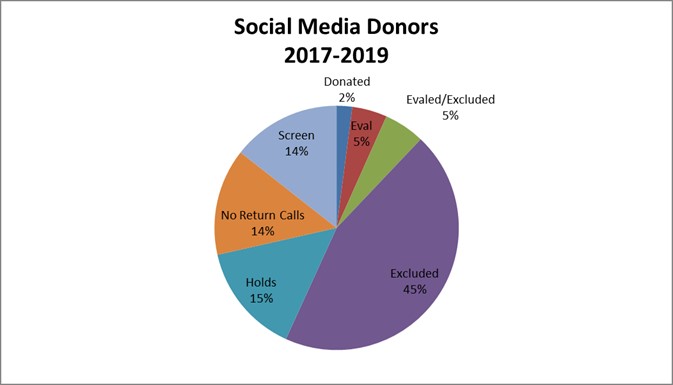Facebunk: Does Social Media Have a Positive Impact on Living Kidney Donation
1Nephrology, University of Rochester Medical Center, Rochester, NY, 2Surgery, University of Rochester Medical Center, Rochester, NY
Meeting: 2020 American Transplant Congress
Abstract number: C-058
Keywords: Kidney transplantation, Living donor, Resource utilization, Screening
Session Information
Session Name: Poster Session C: Kidney Living Donor: Selection
Session Type: Poster Session
Date: Saturday, May 30, 2020
Session Time: 3:15pm-4:00pm
 Presentation Time: 3:30pm-4:00pm
Presentation Time: 3:30pm-4:00pm
Location: Virtual
*Purpose: More kidney transplant recipients are reaching out beyond their immediate contacts in order to find potential living donors. In addition, transplant centers and organizations are adding to this effort by helping recipients find donors in various social media forums. The exact impact and success of social media campaigns to find living donors is not yet completely understood.
*Methods: A retrospective chart review was completed looking at all donors and their recipients that contacted the transplant office to be potential living donors between 2017 and 2019*. Inclusion criteria consisted of at least one donor responding to a social media post for the intended recipient. All donors for the recipient were then examined to see where they were in the living donor screening process. This was compared to all donors and their recipients in the same time frame that did not post a known social media ad.
*Results: As of October, 2019, 386 donors contacted our transplant center interested in being a living donor for someone who had a social media campaign. This consisted of 43 recipients leading to 9 calls per recipient. In comparison, there were 988 donor phone calls for recipients who did not have a known social media ad for 413 recipients leading to 2.4 calls per recipient. In comparing status in the evaluation process, social media donors had a higher rate of exclusion on phone interview (46% vs 39%) compared to non-social media donors. They also had a lower rate of being evaluated (14% vs 10%) and lower rate of actually donating (7% vs 2%). Even then, of the eight transplants that occurred for social media recipients, only two of those actually occurred due to their social media campaign.
*Conclusions: While social media campaigns increase the chances of having potential living donors calling, the quality of those donors and the likelihood of moving forward to donation is lower than donors who have closer ties to their recipient. The focus of recipients should be discussion for need of a living donor in their more immediate circle and branching out instead of using social media as their first approach.
To cite this abstract in AMA style:
Venniro EK, Kashyap R, Taylor JG. Facebunk: Does Social Media Have a Positive Impact on Living Kidney Donation [abstract]. Am J Transplant. 2020; 20 (suppl 3). https://atcmeetingabstracts.com/abstract/facebunk-does-social-media-have-a-positive-impact-on-living-kidney-donation/. Accessed November 23, 2025.« Back to 2020 American Transplant Congress


